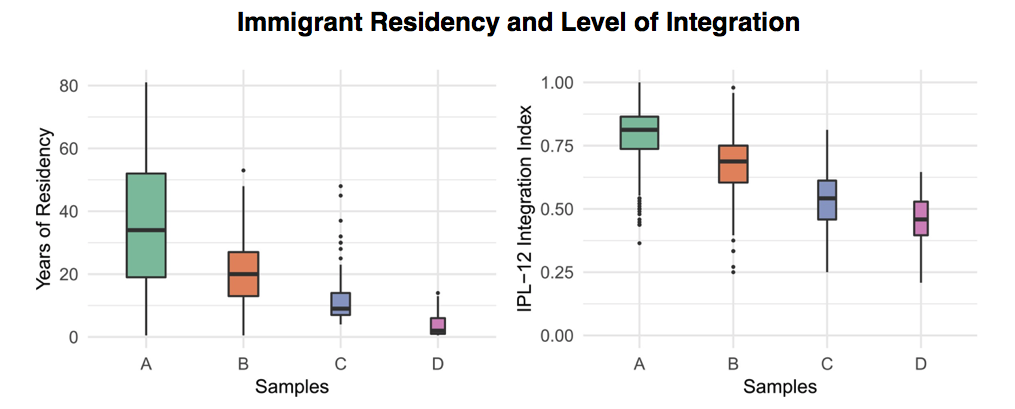
How well are immigrants integrating in the United States? Are they doing better or worse than in Germany or France? Under what conditions have immigrants most successfully integrated into their host societies? Despite great advances in social science, the answers to these important questions remain contested.
There are now over 250 million international migrants throughout the world. Each has a unique story, and many face deep challenges not only to establish a new home but also to build a new life once they arrive. Policymakers throughout the world have grappled with how best to integrate newly arrived immigrants to ensure that the economic and societal benefits of immigration become a reality. And they are doing so without clear guidelines as to what policies work best.
A key challenge to date for policymakers and service providers is that there is no common approach to measuring immigrant integration. As academics have offered vigorous debate on the meaning of “integration” and used varied definitions and measures in hundreds of studies, it would be nearly impossible to generate systematic knowledge to assess and improve immigrant integration, because the benchmark is constantly being moved. What’s learned from one study or evaluation of a policy is of little systematic value, relative to another study, because the concept of “integration” keeps changing.
This barrier is not insurmountable. Just as researchers have created widely accepted measures of country wealth (GDP) and mental health (the Kessler-6) to build cumulative knowledge, there is an opportunity to generate systematic and pragmatic information about immigrant integration as well.
Researchers at the Immigration Policy Lab at Stanford University and ETH Zurich developed a new pragmatic survey tool to measure immigrant integration. The IPL Integration Index provides researchers, policymakers, and service providers with quick and easy-to-implement survey modules to measure various dimensions of integration. The measure is available in a 12-item short form (IPL-12) and 24-item long form (IPL-24).
Integration: A multidimensional concept
Academic researchers have offered varied definitions of integration, and most would likely agree that integration is a complex concept and cannot be measured by a single question. Therefore, the IPL team focused on developing a pragmatic survey tool that would be capable of capturing integration’s various dimensions. The IPL-12/24 includes six key dimensions of integration: psychological, economic, political, social, linguistic, and navigational.
To develop questions for each dimension, the researchers applied seven criteria to potential questions in reviewing a multitude of surveys. The criteria for questions include, for instance, directionality, so that higher values are associated with higher levels of integration, and inclusivity, so that the question could be answered by all adult immigrants and host country natives to avoid issues of missing data. Using multidimensionality and the criteria as a guide, the team tested over 200 questions through almost 4,000 interviews.
The goal of the project is to create a survey tool that government agencies, nonprofit service providers, and academic researchers could all use to build more knowledge. In turn, this can inform policy development and programmatic innovation to support the integration of immigrants.
Creating a valid survey tool
After exhaustive testing to select a final set of questions, is there a way to determine whether the IPL-12/24 accurately measures integration? Since researchers can’t exactly take out a ruler to determine how close or distant the index is to capturing levels of integration, there are a number of ways to assess the validity of the index.
“What you hope to demonstrate in testing the validity of the index is that it shows higher levels of integration where you would expect, such as naturalized citizens having higher levels of integration than recently arrived immigrants,” said Niklas Harder, a postdoctoral fellow and co-author of the study.
The results from a wide range of empirical tests strongly suggest that the IPL-12/24 is capable of differentiating between levels of integration across groups of immigrants and tracks well with commonly used predictors of integration (such as citizenship, language of the home country, and length of stay in host country).
For example, IPL researchers computed the index for four sample populations, each with a declining expectation of immigration success: at one extreme, a sample of computer savvy and wealthy immigrants who were fluent in English (Sample A); at the other extreme, a class of recently arrived immigrants who were enrolled in an English as a Second Language class (Sample D). As expected, the overall integration index declines with less exposure to the host country. The declining integration scores from A to D, in conjunction with other tests, gave the researchers confidence in the validity of the measure.

A pragmatic tool to inform policy
The goal of the project is to create a survey tool that government agencies, nonprofit service providers, and academic researchers could all use to build more knowledge about integration that is comparable. In turn, this can inform policy development and programmatic innovation to support the integration of immigrants. To be sure, the designers of the IPL-12/24 recognize that this index does not capture all aspects of integration. Their goal was to develop a tool that can provide a core measure of integration to generate cumulative knowledge. Other researchers are invited to add and build upon it to enhance its validity as a general measure. “If we want to improve our understanding of what affects integration, we need a common starting point,” said David Laitin, faculty co-director of the Immigration Policy Lab.
The IPL-12/24 website facilitates widespread adoption (www.integrationindex.org). On it, the index is publicly available in a variety of languages and formats for use in multiple countries. “The hope of the Immigration Policy Lab,” as articulated by David Laitin, “is that the dissemination of this research tool will help policymakers learn about the relative merits of their integration policies in a way that will benefit both immigrants and the communities in which they settle.”
LOCATION
Global
RESEARCH QUESTION
Can policymakers, nonprofits, and researchers effectively and efficiently measure immigrant integration?
TEAM
Niklas Harder
Lucila Figueroa
Rachel Gillum
David Laitin
Dominik Hangartner
Jens Hainmueller





